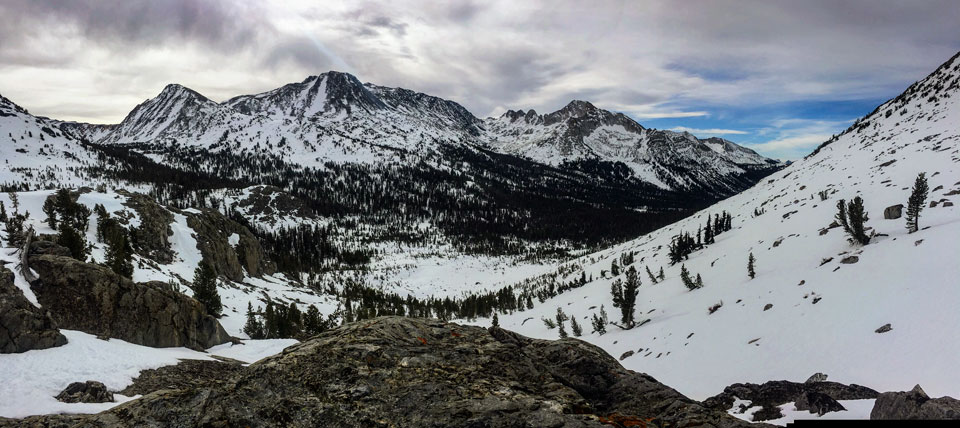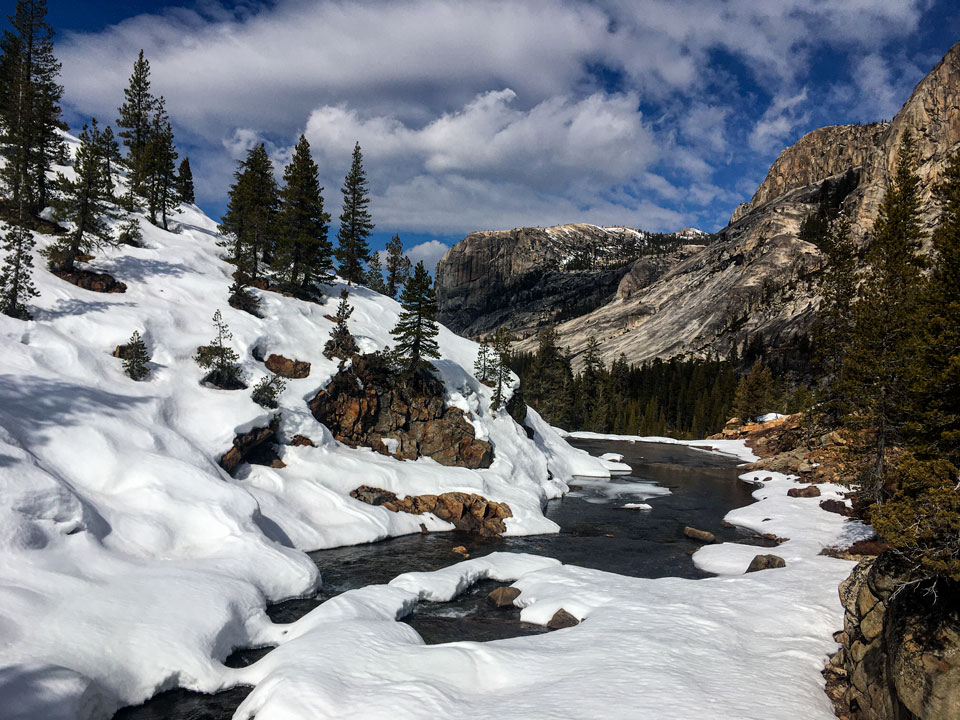
Total settled snow depth: 25 inches (at 8,600 feet)
High temperature: 54°F (March 3)
Low temperature: 12°F (March 2)
February Weather Summary
New snow: 1 inch (Tuolumne Meadows average: 62.1 inches)
New water: 0.06 (Tuolumne Meadows average: 4.53 inches)
Average temperature: 28.6°F (Tuolumne Meadows average: 25.2°F)
March 1 snow survey results: Tuolumne drainage snowpack is 34% of average
Ski Conditions and Weather
We were delighted to wake up on March 1 to fluffy, white snow blanketing the ground! Coming on the heels of the driest February ever measured at our weather plot, it sure was a welcome sight. But what Mother Nature giveth, she can also taketh away. March 2 was one of the windiest days of many this winter. Furthermore, warm temperatures this week have taken its toll on the already meager snowpack. South-facing slopes at the middle elevations are now mostly bare and the only places still holding consistent snow coverage are north aspects, the road corridor, and the meadows and drainages. Above 10,000 feet, where there is good snow coverage, the snow surface has been so hammered by the wind that the skiing is pretty adventurous.
Based on the above dismal snow and weather synopsis, one could easily surmise that sitting in the sun with a good book would be the activity of choice these days. You know what they say about a “bad day of skiing” however, and we are snow rangers after all. We took advantage of a good four-day weather window this week in order to assist in an ongoing carnivore study. We did a patrol from Virginia Lakes to Tuolumne Meadows. Snow coverage was good enough to keep our skis on nearly the entire journey and we found some pretty decent conditions for touring. Camping in the winter environment has such a different vibe than during summer. It is very peaceful. Travelling by skis through the wilderness is such a unique way to experience the grandeur and serenity of the Sierra Nevada.
Caltrans had moved most of the snow off of the road east of Tioga Pass prior to recent weather events. But, coverage is very dynamic given the winds and upcoming forecast.
Avalanche and Snowpack Conditions
For the avalanche advisory for this area of the Sierra Nevada go to https://www.esavalanche.org/ for the Eastern Sierra Avalanche Center.
Presently the avalanche hazard in the Tuolumne Meadows area is low. There may be isolated pockets of wind slab. Hard and potentially hazardous (i.e., slide-for-life) snow surfaces exist at the higher elevations. Ice-axe and crampons are recommended.
Wildlife
We heard the American pika alarming in two very different locations this week. One in the talus on Spring Hill east of Tenaya Lake and one in upper Virginia Canyon. It seemed a bit early to hear their shrill chirps, but the temperatures were warm and the snowpack was shallow. These cute little alpine critters (also known as “rock rabbits”) are very sensitive to the weather and are quite vulnerable to changes in the climate. They don’t hibernate in winter, but tend to stay underneath the snow and talus feeding on the haystacks of alpine vegetation that they spent the summer gathering and curing in the sun.
General Info
For those visiting the Tuolumne Meadows Ski Hut from the east (only) permits are self-issued at the Ski Hut. For those entering from other areas, please see Yosemite’s website: https://www.nps.gov/yose/planyourvisit/wildpermits.htm (#3: Do I need a wilderness permit during winter?) or you may contact the wilderness office at 209/372-0740. There is no phone service in Tuolumne Meadows. We can be contacted regarding winter travel to Tuolumne Meadows via email, but we may be delayed in responding if we are on patrol.
 .
.
